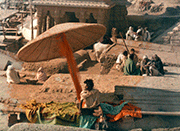E-Archive
Off the Beaten Track
in Vol. 17 - January Issue - Year 2016
In Living Color

Painting by the river in 1925

On the Ganges in 1926
The last stretch required greater effort, as the unpaved country road rose uphill towards the old mansion that gradually appeared like a beacon in the early morning mist. The teenager was forced to stand on the pedals. "These two brothers must be crazy!" he mumbled to himself as he carefully guided his overloaded and wobbling bicycle around the numerous potholes. "What in the world are they doing with all these potatoes that I've been delivering every day? Surely they can't be eating them!" He was soon forced to keep his mouth shut as he huffed and puffed his way to the top of the hill.
*****
Photographs taken between the end of the 1800s and the beginning of the 1900s are generally associated with black-and-white technology, but what is little known is that the science of color photography has been studied as early as the 1840s. The first crude attempts at creating color photographs could not overcome some crucial problems such as the extremely long exposure times needed - up to days at a time - or the fact that the colors would quickly fade when exposed to light for viewing.
Inspired by the theories of Scottish physicist James Clerk Maxwell, in 1861 a permanent color image of a tartan ribbon was created by combining three separate images taken through red, blue and yellow filters. In the second half of the century, several theories and methods were experimented with producing varying degrees of success, but none had any practical value. The breakthrough came at the beginning of the twentieth century, thanks to Auguste and Louis Lumière.
Encouraged by their father, a painter with a keen interest in the relatively new technology of photography, in the late 1800s, the Lumière brothers had become very successful businessmen thanks to their development of an excellent black-and-white photographic plate. By 1894, their factory in Lyon, France, was producing over fifteen million of these plates a year. The financial security afforded by this success allowed them to concentrate on other forms of image technology, in particular, on that of the moving image. At the end of the century, they patented several inventions that led up to the art of cinematography. Although other researchers had presented various systems for creating moving images in previous years, the Lumière brothers' first film, shot in 1895, is considered the first true motion picture in history.
Strangely enough, Auguste and Louis Lumière considered cinema as an invention without a future and consequently abandoned any further development on the related technology. They soon turned their attention to what they considered the only real challenge worth pursuing, that of coming up with a practical and viable method of creating color photographs.
In 1903 the Lumière brothers patented the Autochrome process, based on, of all things, fine particles of potato starch!
Their first experiments, carried out in great secrecy at home, showed that by drying and grinding potatoes into grains of about five to twenty-five microns in size, they could obtain a medium that would allow them to apply the three-color method for creating color photographs. This method, formulated by Maxwell in 1855, is based on the Young-Helmholtz theory, which states that all colors perceived by the human eye are either red (or reddish-yellow), green, blue or combinations of these colors in various proportions.
In the Autochrome process, the fine potato starch grains were separated into three batches. Each batch was dyed a different color: red-orange, blue-violet and green. The three batches were then carefully blended to ensure that the three colors were evenly distributed. The next step was to apply a thin layer of clear lacquer on a glass plate and, while the lacquer was still wet, apply a layer of the colored starch grains. Excess starch particles were removed so that only one layer of grains remained attached to the glass plate. The plate was then pressed through steel rollers to flatten the grains and any gaps between the particles were filled in with carbon black. Another layer of clear lacquer was applied to hold the starch grains firmly in position before the final touch, a layer of light-sensitive silver bromide emulsion.
Photographers received the new invention with great enthusiasm, and supply could not keep up with demand. The French philanthropist Albert Kahn sent a team of photographers to document life and landscapes in fifty countries around the world, and his collection of 72,000 Autochrome photos is housed in the Albert Kahn Museum outside of Paris. The National Geographic Society holds a collection of over 15,000 Autochromes, some of which have appeared in its magazine over a span of twenty years.
By Giovanni Gregorat, Contributing Editor MFN
Author: Giovanni Gregorat




























